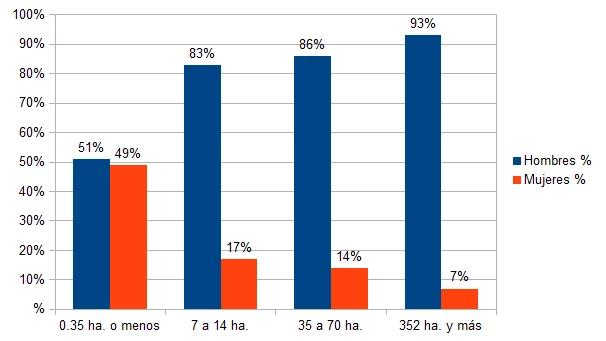 La campaña mundial “Stand for Her Land” se enfoca en aumentar el acceso y control de la tierra para las mujeres. Foto: María José Casanova
La campaña mundial “Stand for Her Land” se enfoca en aumentar el acceso y control de la tierra para las mujeres. Foto: María José Casanova
It is hard to believe that only 70 years ago, in most Latin American countries, women could not vote. Or even more recently, women’s access to land under agrarian reforms depended on factors like the consent of the male head of household or being a widow. During these times the concept of a working woman was virtually non-existent!
Fortunately, much has changed since then, particularly in Central America. For example, in Nicaragua, 51% of property titles granted through land regularization projects were registered to women, compared to only 9.7% in 1989. Similarly, in Panama between 1992 and 2010, this figure rose from 27.8% to 34.48%.
In neighboring Costa Rica, Mujeres y Pobreza (Women and Poverty), a publication by the Instituto Nacional de las Mujeres (National Institute of Women), indicates that 95% of land awarded by the government between 2003 and 2006 was registered in the names of both the man and woman.
While those of us who manage land access programs can take heart in this progress, we must also ask ourselves the following question: Is this a case of a mission accomplished?
To respond, we must first separate overall figures (urban-rural) from those focusing exclusively on access to agricultural land. In the case of the latter, a wider gender gap persists. For example, the current overall figure in Honduras is estimated at 40%, while in the rural area, land registration in women’s names falls to 25%.
(Hombres – Men; Mujeres – Women; 0.35 ha. O menos – 0.35 hectares or less ; 352 ha. y más – 352 or more hectares)
A separate analysis must also be done on the quality and size of the land parcels to which women have access. For this analysis, we use Nicaragua as a benchmark. This is not the only country in the region exhibiting these features, but it has some of the best data on this matter. Based on the 2012 agricultural survey in Nicaragua, while significant progress has been made in the number of women who hold property titles, the number of owners falls considerably as parcel size increases. In plots up to 0.35 hectares, 49% of property is owned by women. However, in the case of 7-hectare plots (10 manzanas), this figure falls to 17%; and in the case of land over 350 hectares (500 manzanas), the figure drops to 7%.
Furthermore, most decisions related to leasing, production, inheritance, and the sale of property still continue to be made by men, a situation illustrated by Gabriel, a land regularization beneficiary in Honduras. When he heard the word “gender” at a land regularization workshop in Honduras he stated forcefully: “In terms of gender, I don’t think things can be so equal; the man always heads the family.”
Gabriel grew up believing that men must be in control in the home; and since it is their responsibility to provide for their families, decisions related to property and the handling of property-related transactions and documents must be made solely by men.
To overcome the gender gap, particularly in household decision making, the challenge lies not only in addressing the percentage of land plots registered in women’s names, but also in promoting the involvement of women in land-related decisions and the control of productive resources – in improving their agency and ability to participate in household and even community-wide decisions. In other words, beyond the policy framework for achieving progress, we must strive for inclusion in terms of access to and control of land.
The “Stand for Her Land” campaign focuses on just this – increasing women’s access to and control of land and property assets so that women can become full and productive members of their families, communities, and countries.
What other factors do you think should be used to gauge whether gender equality exists with respect to land access? What measures do you think can provide women with equal access to land as a means of production? How can we achieve, in a beneficial and respectful manner, a cultural shift in communities, at least with respect to women’s access to land?
We want to hear your views. You can respond in the comments section.




Join the Conversation